
Known in Spanish as Día de los Muertos, Day of the Dead is commonly celebrated every year on November 1 and 2. Although the ritual “belongs” to Mexico, it is in fact a global phenomenon celebrated across Latin America, the US, Europe, Asia and Africa by migrant Mexican communities.
With its Mesoamerican, Roman Catholic and pagan roots, this deeply religious celebration sees families gather annually to honour and commemorate their loved ones. They build altars and parade the streets dressed as skeletons or Catrinas – the “grand lady of the afterlife” – and bake sugar skulls and “bread of the dead”.
But the Day of the Dead is commonly misunderstood in some countries, including the UK, where the perception is that this highly important ritual is simply a Mexican version of Halloween.

My work looks at the way Day of the Dead is viewed and consumed in the UK and Ireland, and how Mexican communities celebrate their customs there. The UK has a Mexican community of around 10,000 people and although not all participate, many will celebrate Day of the Dead from Fife and Dublin, to London and Southampton, as an important way of connecting with each other, and Mexico. The event is a valuable way for Mexicans to foster pride in their cultural heritage, celebrate difference and inclusivity – and showcase how the festivity is not a Mexican Halloween.
In Bournemouth for example, the Mexican community has organised public street events welcoming the wider community by building community altars, offering delicious orange blossom “bread of the dead” and by dancing special folkloric Day of the Dead dances.
Elisa Ponce, founder of the Mexicans in Bournemouth community, and co-founder of the folkloric dance group Colores Mexicanos, which is comprised of Mexican and Latin American women, mothers and daughters, sees their local Day of the Dead celebrations as vital for community cultural pride:
We were so proud to hear the excitement of the passers-by, the conversations about death, suffering and sadness becoming happiness and colours. Just like in Mexico.
Such events create a sense of belonging by passing down cultural heritage from one generation to the next, and raising awareness in the broader public.
The ‘Halloweenisation’ of a Mexican custom
As my previous research shows, interest in all things Mexican has been growing steadily in the UK due to tourism, the media and Day of the Dead events organised by Mexican communities in Britain.
Even though many British people are aware that Day of the Dead is not a Mexican Halloween, the so-called “Halloweenisation” of the practice is still widespread. The two may share similar Catholic origins, but the former has lost its religious roots and is now merely a commercialised phenomenon.
Besides retailers and the media, Day of the Dead’s Halloweenisation has been fuelled by Hollywood movies such as Bond film Spectre (2015) with its Day of the Dead parade, and, to a point, Coco (2018) the Pixar animation about a young Mexican boy who ends up in the land of the dead.
The festival has undergone a worldwide cultural transformation due to globalisation and the internet-based world we live in, which can have a bulldozing effect on individual cultures. This has led to Day of the Dead becoming divested of its local roots and religious meanings, and turned into an object of mass consumerism.
During Halloween, Day of the Dead costumes and accessories have become an increasingly familiar sight in UK shops. With their striking colourful patterns and iconography, it is not difficult to understand the attraction. With British retailers selling Halloween costumes and decorations interchangeably with Day of the Dead items, it’s no wonder that the public may perceive the Mexican practice as simply an extension of Halloween.
Strictly confusing
Still, this Halloweenisation of the Day of the Dead has resulted in fierce debates about whether this is cultural appropriation, capturing polarised opinions spanning allegations of offensive misappropriation to celebrations of cultural fusion.
Nowhere is this response better exemplified than when the Mexican celebration was appropriated by the ever-popular BBC dancing programme, Strictly Come Dancing. In 2018 its Halloween episode featured a colourful Day of the Dead-themed opening dance performance with mariachi singers, sombreros, papier mâche skeletons and dancers donning sexy Catrina dresses and alluring skeleton make-up.
A row followed, with the media picking up on the mixed responses to the controversial performance. The Huffington Post for example reported the performance being blasted for cultural appropriation and featured several tweets from unhappy viewers who found it “racist” and “offensive”.
But others praised the show’s celebration of cultural heritage and its fusion of Halloween, Day of the Dead and the movie Coco, with some drawing delighted comparisons with the popular film that has given prominence to Day of the Dead. Such comparisons suggest that some believe the ritual is based on a film rather than a Mexican religious practice, fuelling further misconceptions of Day of the Dead as “another Halloween”.
With the Mexican community in the UK playing an important role in contributing to the local economy, culture and society, more visibility is needed of the Day of the Dead celebration to break with unhelpful racial stereotypes and issues around mislabelling.
This lack of visibility could be addressed by encouraging retailers to rethink how they sell and brand their items. Local councils could promote and fund Day of the Dead events to the wider community by including them in their post-COVOD social and cultural regeneration strategies. And schools could do more to teach children about what the practice is actually about – and why it’s not an extension of Halloween but something culturally distinct underpinned by its own religious history, meaning and rituals.
Jane Lavery ne travaille pas, ne conseille pas, ne possède pas de parts, ne reçoit pas de fonds d'une organisation qui pourrait tirer profit de cet article, et n'a déclaré aucune autre affiliation que son organisme de recherche.
This article was originally published on The Conversation. Read the original article.







